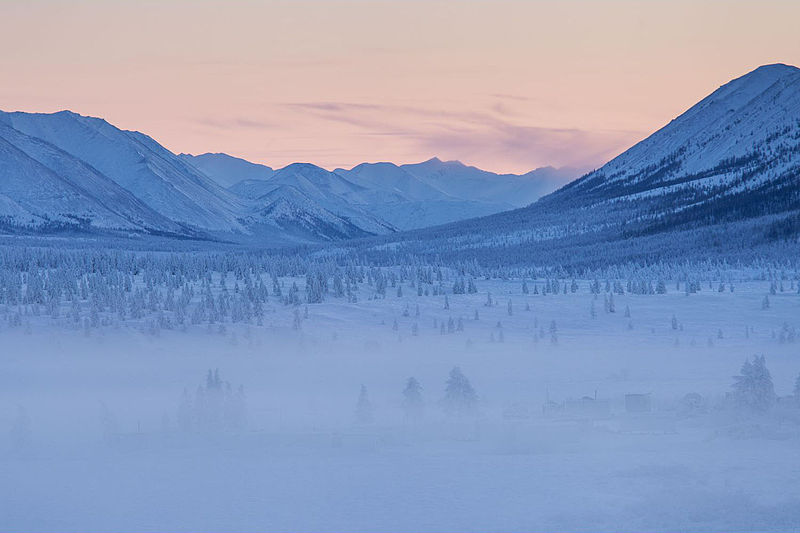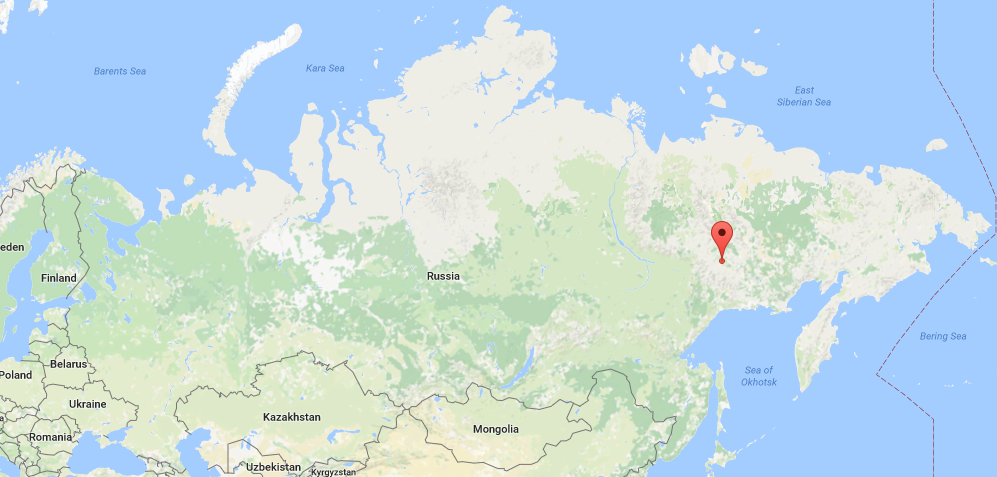Where Ten Degrees Below Zero is Unreasonably Warm

The picture above is a forest, frozen over and covered in ice and snow. The photograph was taken in February of 2013, and, at best, it was -12.5 °C (9.5 °F) outside. We know that because the picture above is from a place called Oymyakon, one of the coldest inhabited places on Earth. The average temperature in February is -42 °C (-44 °F) and that -12.5 °C temperature is the warmest reported February temperature on record.
And that’s not even Oymyakon’s coldest month. That honor goes to January, which is a few degrees colder, on average.

Oymyakon, as that red flag on the map above shows, is in the middle of nowhere, Russia. At 63°27′ north latitude, it’s only about a hundred miles from the Arctic Circle. During the winter months, there are often days with only three or four hours of sunlight, and from October to April, temperatures rarely hit above freezing. At one point in 1924, per various reports, the temperature cratered to -71.2 °C (-96.16 °F). And yet, Oymyakon has consistently been home to a small population of about 500 people.
The people who live there used to be nomadic — or, at least, their recent ancestors were. At some point during the existence of the Soviet Union, the communist rulers decided to set up the town formally, hoping to modernize the culture of Siberian nomads by making them settle down in a permanent location that doubled as a trading post. It seemed to have worked: even though (or maybe because) the village is a two day trip from the nearest city, Yakutsk, the people of Oymyakon, by and large, have remained there.
How do people deal with the harsh climate? First, there’s “Russian tea,” as the Weather Channel jokes — that, of course, is vodka. But there are more serious concerns than can be cured by the false sense of alcohol-induced warmth. The Weather Channel continues:
The frozen ground makes it difficult for working indoor plumbing, so most toilets are outhouses. The bitter cold also makes it difficult to dig graves. The ground has to be warmed with a bonfire before a funeral. Locals use heated garages for their cars. Cars left outside need to be kept running, otherwise they will not restart. Planes cannot fly into the area in the winter. And of course the risk of frostbite is great after only a few minutes in the cold.
And that’s only the start of it. Because you can’t grow crops in frozen ground, the people of Oymyakon generally live on an eclectic menu of meat; per Wired, “reindeer meat, raw flesh shaved from frozen fish, and ice cubes of horse blood with macaroni are a few local delicacies.” Similarly, the harsh climate means that growing up there means you don’t miss school because of the snow. Atlas Obscura notes that “children of Oymyakon are stuck in class unless the temperature falls below –52C.” Then again, being in class is probably better than being outside.
If you’d like more pictures of Oymyakon, the Weather Channel link above has a good selection.
Bonus fact: It should go without saying that Oymyakon doesn’t have good cell phone reception — being hundreds of miles from a city will usually do that. But even if it did, your phone wouldn’t work there. Few, if any, electronics would — it’s simply too cold. But you don’t need to travel to areas of extreme temperatures to experience this yourself, especially if you have an iPhone 5S — you may just need to go outside on a cold day. That phone “can withstand temperatures between -4° and 113° Fahrenheit” per CNN, and that’s when it’s turned off. (That’s -20 °C to 45.5 °C.) Turn it on, and it will begin to struggle at 0 °C/32 °F. The reason? As Motherboard explains, “the cold slows the conversion of the battery’s stored chemical energy into electrical energy—a battery operating at 0 degrees Fahrenheit delivers only 50 percent capacity of what it would deliver when operating at 80 degrees Fahrenheit. Next thing you know your phone is dead, all because the cold put a stranglehold on your battery.”
From the Archives: Why Cat Owners in Siberia Really Need to Pay Their Taxes: Really.
Related: “One Day in the Life of Ivan Denisovich” by Alexander Solzhenitsyn. The classical fictionalization of a Soviet dissident sent off to a Siberian prison camp. More than 450 reviews combine for an average of about 4.5 stars.
